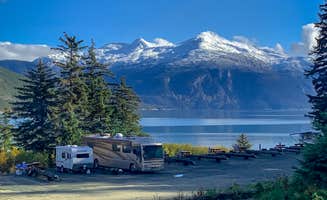Chilkat State Park sits at the end of Mud Bay Road, approximately 10 miles south of Haines, Alaska, offering campsites with views of the Lynn Canal and surrounding coastal mountains. The camping season in the Haines area typically runs from mid-May through mid-September, corresponding with the region's milder weather and extended daylight hours. Smaller RVs under 30 feet can access several campgrounds, though larger motorhomes face limitations at more remote locations.
What to do
Wildlife viewing at Chilkoot Lake: Chilkoot Lake State Recreation Site provides prime bear viewing opportunities during salmon runs. "Keep an eye out for wildlife, there are lots of grizzlies around," notes one visitor to Chilkoot Lake State Recreation Site.
Historical exploration in Dyea: Visit the abandoned gold rush town site near the Dyea Campground. "Dyea has such amazing history. There's a bar/restaurant/Airbnb on the way. The sweetest woman runs it and she'll tell you all you need to know about the area," shares a camper about Dyea Campground.
Water activities: Launch your boat or kayak from Chilkat State Park's boat ramp. "This site is a great basecamp for boating but there are also some great trails within the park. You can see to the mainland on both sides of the fjords so bring the best binoculars you can afford."
What campers like
Shoulder season visits: September offers fewer crowds and beautiful foliage. A Dyea visitor reports, "I suggest going in September. The weather is perfect-not too cold, solid breeze but warm sunshine. The leaves start to change to a beautiful yellow."
Easy town access: RV parks in downtown Haines provide convenience. "The advantage to be here is the convenience to walk to the train station for tours, and also downtown. Reasonable price," mentions a camper at Pullen Creek and RV Park in nearby Skagway.
Wilderness camping at Dyea Flats: For dispersed camping, the flats beyond the main campground offer solitude. "You can camp on the outskirts of the grounds for an open view of the flats, or get a more secluded spot in the trees. It's a dream," writes a Chilkat Bald Eagle Preserve visitor.
What you should know
Tidal awareness: At Dyea Flats, campers must position their vehicles carefully. "Do not park too close to the beach - it has an infamously high tide. You'll see the algae lines from past tides," warns a camper.
Cell service variability: Mobile coverage exists primarily in town and at select campgrounds. One camper notes, "AT&T cell service as good as in town when in the day use area" at Chilkat State Park.
Bridge clearance concerns: The road to Dyea has limited clearance. "Road is curvy and rough with a low bridge, so don't attempt if your over 11'1". Short drive to town, great views, and an interesting walk through the interpretive part of the park."
Tips for camping with families
Free equipment for kids: Chilkoot Lake offers safety gear for young visitors. "They even have children's PFDs to borrow, should you forget to bring some," notes a Garden City RV Park visitor who explored the Chilkoot area.
Budget-friendly options: Look for municipal campgrounds with basic amenities. "There is a small rustic campground right in town a short walking distance of the fast ferry. That campsite is about $5 and based on the honor system."
Recreational facilities: In Skagway, families can access additional amenities. "Location is convenient next to the rec center and a few blocks from town. The restrooms are clean. There's a coin operated shower and coin operated laundry on site."
Tips from RVers
Size restrictions: Many campgrounds cannot accommodate larger motorhomes. "The approach to the Chilkat campground is on a steep dirt road which is pretty good by Alaskan standards, but the campsites cannot accommodate larger rigs."
Walk-in options: Some campgrounds offer special walk-in sites for tent campers. "For walk-in fans, there are a few lovely sites down near the water... These sites don't offer electrical hookups, so bring your solar panels and/or solar generator."
Double parking setup: At Dyea Campground — Klondike Gold Rush National Historical Park, some sites share parking areas. "There are a few pull-through sites, but the rest have a double-parking set up, where two campsites share a paved parking area and the campsite is to the left or right of the pavement, perfect for small groups."


